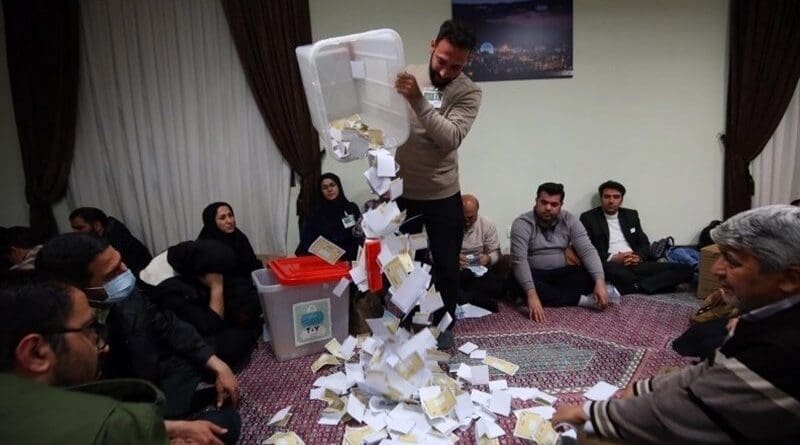Iran: How The Regime’s Elections Became A Total Disaster – OpEd
By Mahin Horri
While Iranian regime supreme leader Ali Khamenei and the main leaders of the regime continue to suffer a heavy blow from the devastating impact of the nationwide boycott of their sham elections, confessions about this undeniable defeat have become prevalent in the comments and writings of regime media.
Heshmatollah Falahatpisheh, the former head of the security commission of Majlis (parliament), said, “The results indicate that the parliamentary elections are a failure, not a victory.”
In an interview with the state-run Setareh Sobh newspaper on March 3, Falahatpisheh said, “It is unprecedented in the history of Iranian elections that to such an extent all the country’s resources are mobilized to push people to the ballot box. Throughout the history of the revolution, all the executive and political capacities did not come into play to this extent. From pleas and requests to threats, everything was employed in the national media to get people to the ballot box. On the day of the elections, all the tools were used in such a way that they extended the voting hours until midnight without any reason. It has even been reported in some cities that mobile ballot boxes were available to visit people’s homes to collect votes. The country is being mobilized for an election in which participation is decreasing day by day, and despite this decline, it is still remembered as an epic event.”
On March 3, the editor-in-chief of the state-run Fars News Agency wrote, “The country’s media and political apparatus performed poorly in convincing the undecided, who accounted for about 30 percent. Participation in this round of elections was 18 percent lower than the average of previous parliamentary elections.”
The state-run Entekhab news agency wrote, “Undoubtedly, the elections of this parliamentary term can be considered the least lively elections in the history of the Islamic Republic.”
On March 2, the state-run Bahar News website wrote, “In Tehran, about half of the candidates with approximately three to six percent of the eligible votes will enter the Majlis in the first round.”
A regime reporter wrote, “The statistics of the representatives in this session of the Majlis indicate that many of them have obtained four or five percent of the votes of eligible voters.”
Another noteworthy point in this farcical election is the exceptionally high number of invalid votes. Invalid votes were so prevalent that they ranked first or second in many cities, and in Tehran, half of the participants cast invalid votes.
On March 3, the state-run Etemad newspaper wrote, “The preliminary results of the parliamentary elections, based on official and unofficial statistics, indicate the highest decrease in voter turnout and an increase in invalid votes. Considering the proximity of the number of votes obtained compared to the previous period and the unprecedented decrease in candidate votes, it appears that a significant portion of the votes were invalid. To the extent that some have speculated that invalid votes account for the first and second place in the Tehran electoral district.
On March 3, the Telegram channel for Chand Sanieh news outlet wrote that the invalid votes in Tehran also ranked second. More than 500,000 votes, equivalent to 27 percent of the votes cast in Tehran, were invalid.
On March 3, the state-run Shargh newspaper wrote, “In some constituencies, such as Marvdasht, the number of invalid votes exceeded the votes for the first candidate.”
Mohammad Mohajeri, a journalist close to the principlists, said, “The results of the parliamentary elections in most cities, including major cities such as Tehran, are strange and interesting. It means that the first or second candidate has received invalid votes.”
Bahar News added, “While the electoral district of Shahriar, Qods, and Malard has a population of nearly one and a half million, the principlist representative of this city entered the Majlis with 56,529 votes. This is even though in this district, there were 54,195 invalid votes, which is an unprecedented number!”
Hossein Saremi, an active member of the principlist camp, said that in Tehran, half of the people who participated in the elections cast invalid votes!
Abbas Javaheri, the head of the Tehran Province Election Headquarters, also said, “There is a possibility of a runoff in the constituencies of Tehran, Rey, Shemiranat, Eslamshahr, and Pardis, as the candidates need to secure 20 percent of the votes.”
The Jomhurieh Eslami (Islamic Republic) newspaper wrote on March 3, “In the eleventh parliamentary elections, the voter turnout was 42.57 percent, and now there is a 1.57 percent decrease compared to the previous term. This has raised an important question that the authorities of the system need to consider and find a solution to prevent this declining trend in participation.”
According to reports by the PMOI, the real turnout was around 8.2 percent.
However, the reality is that the time for finding a solution has passed. The nationwide boycott demonstrated the dissatisfaction of the Iranian people with the authoritarian rule of the mullahs and the sham electoral process. Once again, it reaffirmed the fact that it is time for a revolution.

